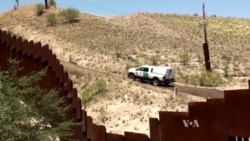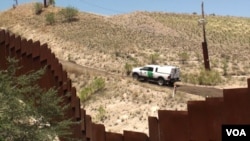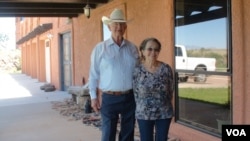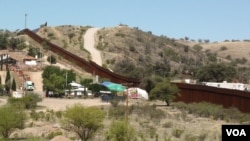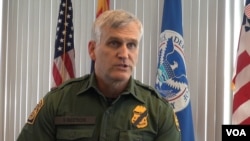Many U.S. voters support Republican presidential candidate Donald Trump’s proposal to build a big wall along the more than 3,000-kilometer U.S.-Mexico border, but a poll released this week shows that a majority of the people who actually live along the border are against it.
Eighty-six percent of border residents in Mexico and 72 percent of residents on the U.S. side oppose the wall, according to the survey, which was sponsored by Arizona State University’s Cronkite News, the Spanish-language television network Univision and The Dallas Morning News.
That result came as no surprise to people familiar with the border, where Mexican-Americans with cultural and family ties across the boundary are in the majority. People in populated areas like Nogales also complain about the wall they already have. A large metal barrier built several years ago divides Nogales, Arizona, on the U.S. side from Nogales, Sonora, on the Mexican side. Few people find the barrier attractive.
Trump has said he would demand that Mexico pay for what apparently would be a still-larger wall that he would build if elected. He said he would threaten to disrupt the flow of money sent back to Mexico by immigrants if Mexico balked at paying for the wall. Remittances from Mexicans living legally and illegally in the United States account for that country’s second source of income behind oil production.
Limited barrier
The current barrier extends into the desert hills on either side of the main crossing in Nogales, and U.S. Border Patrol vehicles are a frequent sight on the roads nearby.
Authorities take all unidentified bodies found in the border area in Arizona to the Pima County Medical Examiners Office in Tucson, where the count so far this year is 75. The Border Patrol has found about 6,000 human remains on the southwest border since 1998.
Most illegal entries take place farther out, though, where the barrier ends and there is only a barbed wire cattle fence along the international boundary. There are crossings on a nightly basis, as shown by both Border Patrol and private motion-activated cameras set up in the area.
A friend helped rancher Jim Chilton set up cameras on his 20,000-hectare ranch. Images from the cameras show people carrying heavy loads through the desert terrain.
Chilton, 77, discovered what he said were drug smugglers outside his house one night.
“I counted 17 guys in my front yard — they were obviously drug packers,” he told VOA. “I said, ‘Agua? [Water?]’ and they said, ‘Si [Yes],' so I turned on the hose, they had their drinks, thanked me and left.”
While the encounter was peaceful, Chilton said he was holding an automatic rifle in his hands the whole time. He also sleeps with guns near his bed in case of an intruder. The nearest law enforcement officer is at least an hour’s drive from Chilton’s ranch house near Arivaca, Arizona.
“We are our own law; the law is in our holster,” he said.
Dangers in the desert
Chilton and other ranchers along the border in Arizona have come together to ask for more protection. Two ranchers have been killed in recent years, and at least one other had to abandon his ranch after a fire allegedly started by drug smugglers burned off the grass that fed his cattle.
Illegal immigrants often cut water pipes when they are desperate to drink, leaving cattle farther down the line without water. The smugglers and migrants have also damaged fences and stolen property from ranch houses and sheds.
Chilton likes Trump’s plan to build a wall, but he thinks more could be done right now by the Border Patrol to beef up enforcement at the remote sites where people cross the border all the time, often ending up in distress.
“If they secured the border,” he said, “people would not be dying on our ranch, people wouldn’t be raped, people wouldn’t be attacked, beaten up. We have had all of that on our ranch.”
Border efforts
U.S. Customs and Border Patrol agents are charged with preventing illegal entries and all forms of smuggling, but they also go after rapists and bandits and provide first aid to injured migrants. Paul Beeson, chief of the U.S. Border Patrol’s Tucson Sector, told VOA the border is not being neglected.
“We do have, on any given day, Border Patrol agents deployed all along the southwest border in the Tucson Sector,” he said.
In addition, Beeson said, the Border Patrol utilizes everything from horseback agents to helicopters to secure the border. But, he said, smugglers also are equipped with sophisticated resources that help them avoid capture.
“There are individuals who are sitting up on the high points on the mountains around here and doing countersurveillance on us, watching our activities,” he said.
Opinions differ
But the question of what to do about border security divides opinions in southern Arizona as much as the walls, fences and other barriers divide one country from another at the border.
The Reverend Randy Mayer of the Good Shepherd Church in Sahuarita, Arizona, said the security measures implemented on the border in recent years, including the big barrier he calls “the wall,” have needlessly offended Mexicans and diminished the trade and commerce that might have flourished there.
Standing near the barrier, Mayer said, “This wall signifies a lack of respect for our neighbors and people we should be embracing and building bridges toward.”
Local ranchers, business owners and civic leaders also favor better relations at the border and less strident rhetoric about the situation there. But most of them also stress the need to enforce U.S. laws and to keep residents safe.




